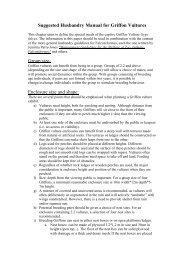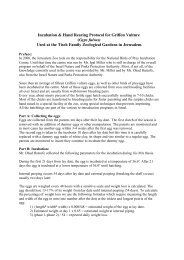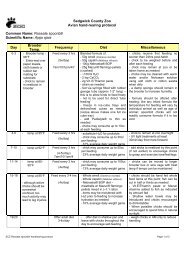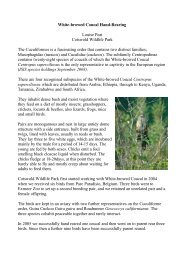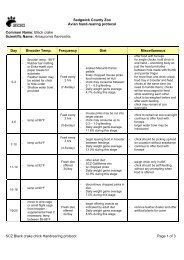Breeding White Storks - Avian Rearing Resource
Breeding White Storks - Avian Rearing Resource
Breeding White Storks - Avian Rearing Resource
Create successful ePaper yourself
Turn your PDF publications into a flip-book with our unique Google optimized e-Paper software.
<strong>Breeding</strong> <strong>White</strong> <strong>Storks</strong>(Ciconia ciconia)<br />
at Chessington World of Adventures<br />
Paul Wexler<br />
The <strong>White</strong> Stork belongs to the genus Ciconia of which there are seven other species<br />
incorporated predominantly throughout the Old World, but with one species in the New World.<br />
Ciconia ciconia classifies two sub species, the nominate being found through much of Europe<br />
and wintering in Africa. Its sub species C.c.asiatica has a smaller eastern distribution in Turkistan<br />
and winters mainly in India and Iraq, as well as Oman and the United Arab Emirates. It is<br />
distinguishable from the nominate by being generally larger and the bill being redder.<br />
Preferred habitats for the <strong>White</strong> storks are more open aspects as they tend not to be a particularly<br />
manoeuvrable in tight or wooded country. Open areas also enable birds to be more aware of<br />
predators because of the increased field of vision. As a group the <strong>Storks</strong> are normally associated<br />
with semi aquatic habitats and although this is true to a point they will also use other areas to feed.<br />
Dry grassland in Africa will often find storks present, as their dietary requirements are not<br />
restricted to aquatic prey. Their food includes most obviously fish and amphibians, but they will<br />
also take reptiles, small mammals, birds and insects dependent on the availability and<br />
opportunity. Indeed their Afrikaans name `Grootsprinkaanvoel’ means `Great Locust Bird’ and<br />
may show other dietary preferences.<br />
Standing at a meter or so tall this long legged bird is certainly designed for a life around water and<br />
long grass habitats. Thus the main plumage of the body is prevented from becoming wet or soiled<br />
as the birds wade in search of prey. The plumage is the same in the male and the female and<br />
apart from being slightly duller, juveniles at fledging are essentially the same, differing mainly by<br />
the duller colouration of the bill and legs. The nuptial plumage of an adult bird is also reminiscent<br />
of the usual plumage only that the feathers are of a newer moult and therefore brighter and<br />
cleaner. This does not last for long especially with the riggers of nesting and rearing offspring.
At Chessington World of Adventures a pair is maintained in a large aviary about 20 meters long,<br />
16 meters wide at its broadest end, narrowing to 12 meters at the other and about 4 meters high.<br />
This enables us to keep the pair free winged as they can therefore reach with ease their nesting<br />
platform situated about 2 meters above the ground in the middle of the flight bordering a pond<br />
which covers about a third of the floor of the flight.<br />
The diet consists mainly of fish, either sprat, mackerel or herring, plus mice and day old chicks<br />
which is fed to the pair in the late afternoon as they have in the past shown little desire to feed<br />
during the day.<br />
The nest platform is about a meter square with a lip around its edge about 10 cm high. The nest<br />
is built with some rather large sticks initially, the size becoming progressively smaller and shorter<br />
as a mattress is built up and finally the lining is of grasses and moss. Most of the nest materials<br />
are collected by the male and dropped at the nest for the female to arrange.<br />
In 1997 nest building was first observed toward the end of February, though the first egg was not<br />
laid until the 18th of April. Instances of courtship display were increased particularly instances of<br />
mutual beak chattering which could be heard several times an hour throughout the day reaffirming<br />
the bond between the pair as well as defining their territory. The first few eggs, for reasons<br />
unknown, were either laid off the sides of the nest or were knocked off. One of these eggs was<br />
actually retrieved from the bottom of the pond relatively intact and an attempt at artificial incubation<br />
was made. The 92 gram egg grew well for the first 11 days before the embryo died. The 24th of<br />
April saw the first egg retained on the nest after which a further six eggs were laid though the<br />
female began incubating from the first egg. Mating was observed throughout the laying and<br />
incubation period.<br />
After 35 days of sitting the first chick was seen on the nest and two days later it was seen feeding<br />
accompanied on the nest by two other siblings. The chicks feeding technique at this stage was<br />
effective if not a little crude. The male would normally collect the food leaving the female brooding,<br />
he would return to the nest initially about twenty minutes after he had eaten, presumably any food<br />
2
would be pre-digesting by the time it was brought to the nest. On his return the female would<br />
stand up over the chicks that would almost instantly begin calling. The male would respond by<br />
regurgitating his catch on to the nest in front of the chicks who would then ravenously feed<br />
themselves trying to force back what ever size pieces of food they could pick up. The female<br />
would also feed herself from the males disgorged offerings not seeming to care too much whether<br />
her young had scavenged enough or not.<br />
On the 4th of June a broken egg and a dead chick were found on the floor of the aviary so the nest<br />
was investigated and found to have two eggs remaining both of which were hatching but quite<br />
cold. Also the younger of two chicks appeared to be rather weak and so was removed for hand<br />
rearing. The weakness of the chick was thought to be because the eldest chick was doing so well,<br />
taking most of each feed as it was presented before the younger birds had a chance to learn what<br />
feeding was about. Initially hand rearing was only to be carried out for a week with a view to<br />
returning a stronger chick to its parents and sibling.<br />
However, the next twenty-four hours were not very straight forward as the two hatching eggs<br />
proved to be weaker than anticipated. Although one chick did eventually hatch it did not survive<br />
for many hours and the chick that was taken from the nest showed no willingness to feed and<br />
needed to be force fed for two or three days. This involved gently opening the beak and placing<br />
small morsels of food at the rear of the tongue from where the chick would need to swallow. This<br />
process was carried out every two or so hours from 8am to 8pm.<br />
On arrival our new <strong>White</strong> Stork was covered in a tight thick white down, the eyes were open and<br />
the head, unlike the legs, was large and well formed and seemed hard to maintain an upright<br />
position. Even at this stage whilst it only weighed 52 grams the baby would still exhibit the<br />
characteristic beak clapping behaviour of its parents. This might have been an indicator of<br />
contentment as it normally happened during and after feeding, the same behaviour was also seen<br />
in the chick that remained on the nest.<br />
3
For the first forty eight hours the brooding temperature was held steady at 35 degrees C.,<br />
thereafter it was dropped by a degree a day until it was taken from the brooder and put under a<br />
heat lamp at eight days old. The decision to move the chick was taken because of a combination<br />
of dry air in the brooder and its rapid growth was causing the skin to dry. This by itself shouldn’t<br />
have been a great problem except for rings of skin drying above the toes on each foot were<br />
seeming to reduce the blood supply and swell the feet.<br />
Weight gains were increasing well after an initial slow start of 2% a day for the first two days to a<br />
massive 44% on day four, the weight by the end of the first week was 156 grams. The growing<br />
chick was able to eat whole rat pups though the diet also consisted of chopped fish and day old<br />
chicks.<br />
Back with the parents the single chick was doing very well with no feeding competition from<br />
siblings and thus it was decided not to return the hand reared chick to the nest as it was felt that it<br />
would not cope and possibly the parents would not accept it back. Whatever the reason the chick<br />
had had an unsteady start to life and was just getting back on course so we decided to keep the<br />
status quo. Incidentally we were also giving two bowls of feed to the adults at this stage as the<br />
temperature of the days were tending to sour uneaten food very quickly and although realistically<br />
this would probably not be the greatest of concerns for a stork it seemed prudent not to take any<br />
unnecessary risks.<br />
At 400 grams and twelve days old the hand-reared chick was feeding independently from a bowl<br />
of whole mice & sprats and chopped chicks, which was presented fresh three times a day.<br />
Weighing ceased at twenty days when at a kilo gram the chick was too big and restless to be put<br />
on scales, growth was still monitorable though as it was noticeably bigger each day and the<br />
feather growth was initially rapid. The only recurring problem was that the legs would splay slightly<br />
as the growing chick did not stand until it was about six weeks old and even then it was very<br />
unsteady and only for minutes at a time. To inhibit splaying the chick was placed in relatively small<br />
containers comparative to its size and given deep layers of substrate so that the legs could not<br />
slide out from under the body.<br />
4
By mid September both the hand reared and the parent reared chicks were almost identical and<br />
ready to make their maiden flights, one was simply to leave its nest platform the other starting to<br />
train for flying in the bird presentation team.<br />
As a species the <strong>White</strong> storks are quite important in a few ways to public collections, as they are<br />
very recognisable to many visitors. Within the industry they can be used as a learning species for<br />
bird keepers, giving a foundation for breeding other, more conservationally sensitive species. In<br />
addition though they are still quite numerable through parts of Europe they are by no means as<br />
well represented as they once were and their decline will take much more work on habitat,<br />
reintroduction and education before it can be turned round.<br />
5



